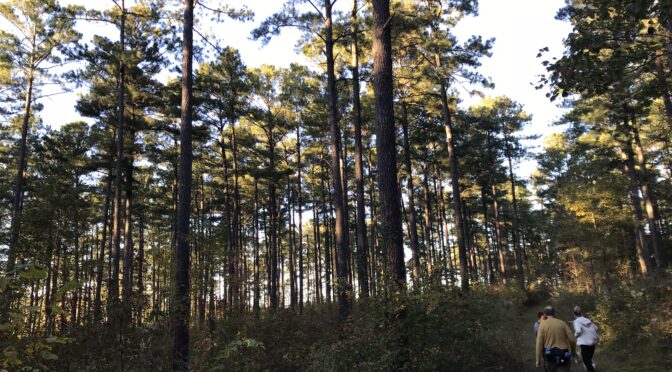It was a Wednesday evening four years ago about this time and we were huddled in a splotch of shade just off the parking lot, waiting for the last hikers to arrive. It was a few minutes before 6; the temperature was trying to drop from the day’s high of 88, with a humidity that seemed to match. We hadn’t taken a single step, but already we were aglow.
Shortly, we set off and within a couple minutes were spared the worst of sun by the thick canopy above. That coverage, combined with our breeze-generating movement, suddenly made it feel 10 degrees cooler.
“Whew! That’s better,” one of the hikers said. And it would continue to get better over the next two hours as the temperature dropped into the 70s.
Summer hiking. To even some avid hikers, it doesn’t exist. Starting about mid-May, fair-weather hikers hang up the boots and begin counting the days until cooler weather returns in mid September. And it leaves us perplexed, frankly. Just because it’s a little (or a lot) warmer doesn’t mean you need to take a hiatus from hiking. Instead, you need to learn to manage the heat, to work with it. One of the best ways to do that is to hike at the two times of day when heat is less of an issue, sunrise and sunset.
Sunrise
It’s commonly assumed that as soon as the sun pierces the horizon, the temperature begins to rise. Not so. In fact, the temperature continues to drop, for a half hour to 45 minutes (or longer), depending upon the conditions. Mike Alger, Chief Meteorologist with KTVN TV in Reno, Nevada, explains.
“Because of radiational cooling, on clear nights the ground gets much colder than the air just a few feet above it. Since thermometers are placed about five feet above the ground, it will show a warmer temperature than the air touching the ground.
“Once the sun comes up, the sunlight excites the cold air in the first foot or so above the ground (which can be 10 or more degrees colder), which causes it to move around and mix into the next several feet of air. That “mixing upward” drops the temperature of the air at thermometer level.”
Alger goes on to say he sees the temperature drop as much as 5 degrees within 45 minutes of official sunrise. From there, it can take a while for heat from the rising sun to pick up steam. The forecast for this Thursday, for instance, shows a temperature in Raleigh of 67 degrees at 6 a.m. (official sunrise: 6:00:16 a.m.), with the temperature only rising to 74 by 9 a.m. Pretty decent temperatures for hiking, in most people’s books. Fall-like, even.
Sunset
The effect of a setting sun on your hiker thermostat, while real, has more of an impact psychologically.
Let’s take the Wednesday hike mentioned above and pretend it’s happening today. The forecast temperature for today at 6 p.m.: 83 degrees. Already, that’s down two degrees from the forecast high of 85. By 7 p.m., the temperature is expected to drop another 2 degrees, and 2 more by 8 p.m., putting it at 79.
Now, 79 is still warm, but it’s already 6 degrees cooler than the day’s high, and 4 degrees down from the temperature when you started hiking. The day is cooling; coupled with the setting sun you’re likely to think it’s cooling more than it is. The fact that simply getting out of your car in the exposed parking lot and walking to the shaded trailhead trimmed about 10 degrees right there.
And, because you likely worked up a bit of a sweat at the start, that sweat is now helping to cool your skin. (One reason we apply a summer asterisk to the admonition “cotton kills” when it comes to outdoor attire; come summer, cotton cools.)
Returning to the trailhead after a two-hour evening hike can leave you feeling refreshed, rather than drained, in the heat of summer.
But the real reason to hike at dawn or dusk? The light. Be it the emerging light ushering in a new day, or the fading sunlight signaling day’s end, the light that shoulders daytime illuminates the reason we hit the trail, spotlighting the best of the outdoor world.
Sunrise? Sunset? The beauty: You don’t even need to choose.
Resources
Sunrise, Sunset Summer Hiking Series. Not crazy about hiking by yourself in the waxing or waning light of day? Join us for a series of eight “shoulder” hikes — two at dawn, six at dusk — on trails we find are especially well-suited for enjoying the best light of the day, Learn more and sign up here.
GetHiking! Guide to Summer Hiking. Hiking at dawn and dusk are two ways to beat the summer heat — and there are more. Learn more strategies for becoming a summer hiker in our Guide to Summer Hiking. Learn more and procure a guide, here.
